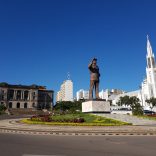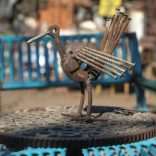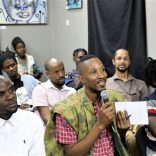Mozambican photographer Mário Macilau featured at AKAA 2025 Art Fair in Paris
Hortêncio Langa: Saying goodbye, and calls for his legacy to be cherished – with videos

Picture: TVM
At 9:00 a.m. this Wednesday, in the chapel of the Military Hospital in Maputo, family members and close friends said goodbye to Hortêncio Langa. Coronavirus restrictions meant that only a few could attend the wake of the iconic musician and multifaceted artist.
Two hours after the funeral, at 11:00 a.m., Hortêncio Langa was laid to rest at the Michafutene Cemetery, in Maputo Province.
The musician, composer, artist and writer passed away this Monday, after an intense life dedicated to music and the arts in general.
For this very reason, colleagues and friends of the author of ‘Magoda’ say his whole opus deserves study.
For Elvira Viegas, for example, it is essential that Langa’s work be safeguarded and disseminated, so that current and future generations can access the artist’s legacy.
“I hope that ARPAC [Instituto de Investigação Sociocultural de Moçambqiue] conducts a survey of his entire opus and keeps it in a place where we, our children and our grandchildren can go to consult [it],” she says.
Viegas worked with Hortêncio Langa for 17 years at the Association of Mozambican Musicians (AIMO), and remembers him as a thoughtful, communicative man, who knew how to share his knowledge with others, and who knew how to be a good father even when the adversities of life reached into his own family.
Elvira Viegas shared the stage with Hortêncio Langa several times. She recalls a tour of Finland they made together.
“He was a spectacular man, and everything he left us will stay forever,” Viegas says, lamenting his passing just when a project he was directing, ‘Casa do Artista Kutenga’, was preparing to honour him.
Another of Hortêncio Langa’s old friends is Wazimbo. They met at primary school in Chibuto, Gaza province. Compulsory military service separated them for a while, but music proved stronger and they met again, creating the band Rebeldes do Ritmo while still young.
Almost 60 years later, Wazimbo admiration is undimmed, and he commends the teachings of his departed friend.
“Generations to come must continue with the work started by Hortêncio. Take the teachings that Hortêncio leaves us and learn the best of those teachings,” he counsels.
When he left home to study in Lourenço Marques, Hortêncio Langa continued to make friends. One of them is Joel Libombo, also a member of the TP50 band. They met in the Maputo’s Chamanculo neighbourhood, 50 years ago.
Libombo remembers his friend as a special person. “Hortêncio had his own characteristics. He was a sincere, affable person, able to give all of himself to see his friend’s problem solved. Above all, Hortêncio was wise, and it is rare to find people like that. If there is anyone who, among our generation, created a turning point in our musical universe, it would have been Hortêncio, it would have been Jaimito. Hortêncio paid attention to social aspects and transferred them into either the canvas or the music. What’s more, he marked an era.”
Hortêncio Langa departed this life just as he, together with his friends and colleagues, was working on the creation of the Mozambican music portal, meant to function as a national music museum. He did not finish that project.
Roberto Chitsondzo recalled Hortêncio Langa’s place in the evolution of the band Ghorwane.
“We met at Hortêncio’s house, before moving on to the Union of Journalists. At that time, he corrected us constantly, because when a band was playing, he had the ability to perceive a detuned string on any instrument,” Chitsondzo recalls. “This is one of the reasons I say Langa was an inspiration for so many young artists of his time.”
In his 51-year career, Hortêncio Langa played with many musicians. He was involved in the band Monomotapa, Grupo RM and TP50. One of his greatest projects was Alambique, founded with Arão Litsure.
“I remember that we were together, playing in a trio with João Cabaço, at a festival in the former German Democratic Republic. We sang there for an hour and a half without realising that they were recording the show. That’s when our first vinyl record came out, containing about 12 songs,” Arão Litsure recalls.
“Later, Hortêncio and I were in Jamaica watching a festival. We were so excited and felt that we could develop our music further by forming a bigger band. That was how we created Alambique,” Litsure said.
“So we [Gorwane] are in mourning because we lost both Hortêncio and Gomate recently,” he said.
Ending his reminiscences, Litsure said that research was needed to uncover more works by Hortêncio Langa, to serve as inspiration for more Mozambicans.
By José dos Remédios












Leave a Reply
Be the First to Comment!
You must be logged in to post a comment.
You must be logged in to post a comment.